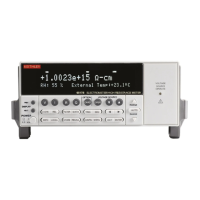Section 11: Remote operations Model 6517B Electrometer Reference Manual
11-12 6517B-901-01 Rev. C / August 2015
Query commands
This type of command requests (queries) the currently programmed status. It is identified by the
question mark (?) at the end of the fundamental form of the command. Most commands have a query
form. Example of querying the timer interval:
:TRIGger:TIMer?
Most commands that require a numeric parameter (<n>) can also use the DEFault, MINimum, and
MAXimum parameters for the query form. These query forms are used to determine the *RST default
value, and the upper and lower limits for the fundamental command. Examples:
Query the *RST default value:
:TRIGger:TIMer? DEFault
Query the lowest allowable value:
:TRIGger:TIMer? MINimum
Query the largest allowable value:
:TRIGger:TIMer? MAXimum
Case sensitivity
Common commands and SCPI commands are not case sensitive. You can use upper or lower case,
and any case combination. Examples:
*RST = *rst
:SCAN? = :scan?
:SYSTem:PRESet = :system:preset
Long-form and short-forms
A SCPI command word can be sent in its long-form or short-form version. The command subsystem
tables in SCPI command reference (on page 14-1) provide the commands in the long-form version.
However, the short-form version is indicated by upper case characters. Examples:
:SYSTem:PRESet Long-form
:SYST:PRES Short-form
:SYSTem:PRES Long and short-form combination
Note that each command word must be in long-form or short-form, and not something in between. For
example, :SYSTe:PRESe is illegal and generates an error. The command is not executed.

